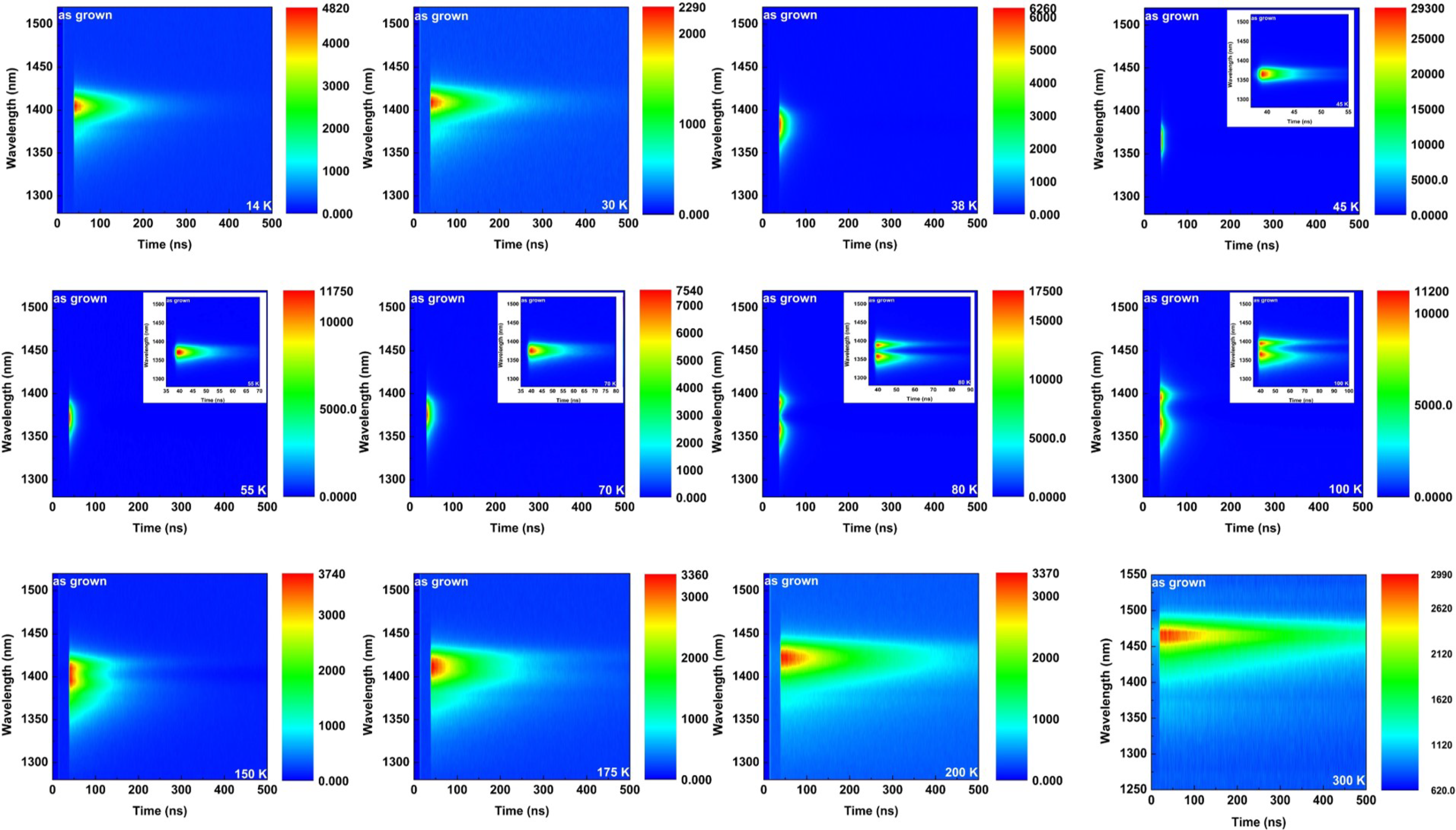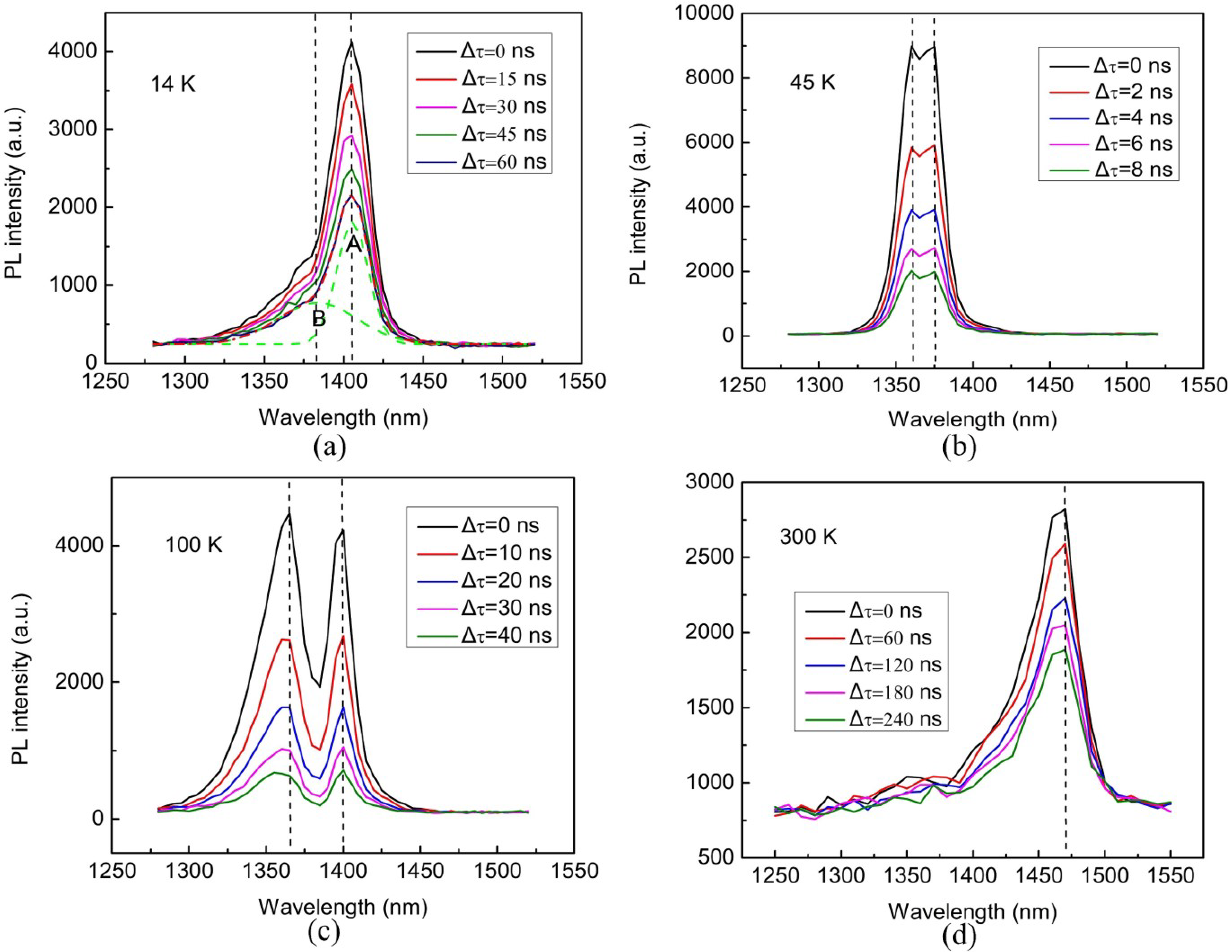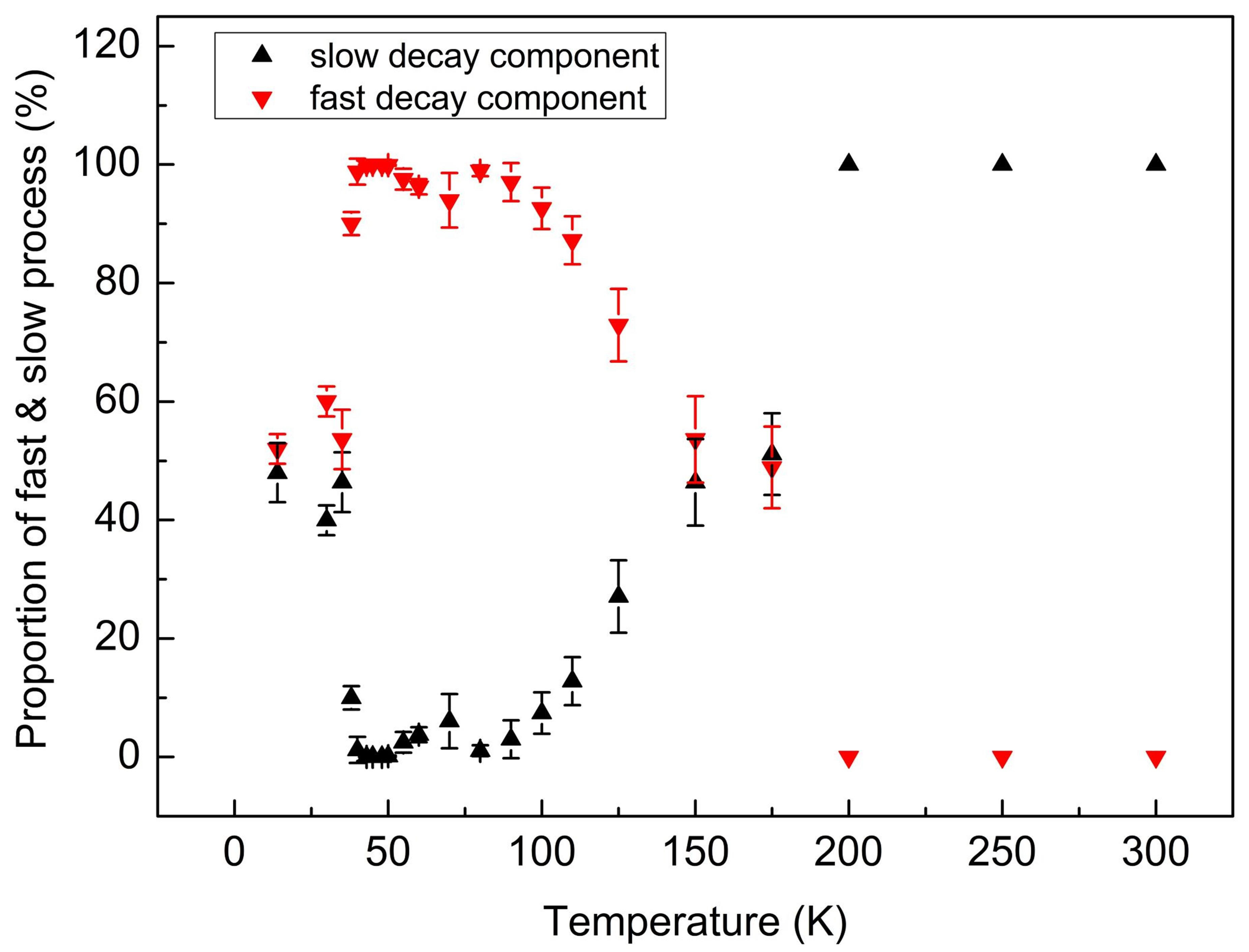Carrier Dynamic Investigations of AlGaInAs Quantum Well Revealed by Temperature-Dependent Time-Resolved Photoluminescence
Abstract
1. Introduction
2. Materials and Methods
3. Results
4. Conclusions
Author Contributions
Funding
Acknowledgments
Conflicts of Interest
References
- Jia, H.; Yin, J.; Zhu, T.; Rao, L. Study of strain-compensated for 1310 nm AlGaInAs/InP multi-quantum-well laser. In Proceedings of the IEEE 15th International Conference on Optical Communications and Networks (ICOCN) 2016, Hangzhou, China, 24–27 September 2016. [Google Scholar] [CrossRef]
- Marmalyuk, A.A.; Ryaboshtan, Y.L.; Gorlachuk, P.V.; Ladugin, M.A.; Padalitsa, A.A.; Slipchenko, S.O.; Lyutetskiy, A.V.; Veselov, D.A.; Pikhtin, N.A. Semiconductor AlGaInAs/InP lasers with ultra-narrow waveguides. Quantum Electron. 2017, 47, 272–274. [Google Scholar] [CrossRef]
- Sweeney, S.J.; Higashi, T.; Andreev, A.; Adams, A.R.; Uchida, T.; Fujii, T. Superior temperature performance of 1.3 μm AlGaInAs-based semiconductor lasers investigated at high pressure and low temperature. Phys. Stat. Sol. (b) 2001, 223, 573–579. [Google Scholar] [CrossRef]
- Sweeney, S.J.; Jin, S.R.; Fehse, R.; Adams, A.R.; Higashi, T.; Riechert, H.; Thijs, P.J.A. A comparison of the thermal stability of InGaAsP, AlGaInAs and GaInNAs quantum-well lasers for 1.3 μm operation. In Proceedings of the IEEE 18th International Semiconductor Laser Conference 2002, Garmisch, Germany, 29 September–3 October 2002; pp. 43–44. [Google Scholar] [CrossRef]
- Sabitov, D.R.; Ryaboshtan, Y.L.; Svetogorov, V.N.; Pasalista, A.A.; Shelyakin, A.A. Strain-compensated AlGaInAs/In quantum well superluminescent diodes in the spectral range of 1.5–1.6 μm. Quantum Electron. 2020, 50, 830–833. [Google Scholar] [CrossRef]
- Pitts, O.J.; Benyon, W.; Springthorpe, A.J. Modeling and process control of MOCVD growth of InAlGaAs MQW structures on InP. J. Crys. Growth 2014, 393, 81–84. [Google Scholar] [CrossRef]
- Caliman, A.; Mereuta, A.; Suruceanu, G.; Iakovlev, V.; Sirbu, A.; Kapon, E. 8 mW fundamental mode output of wafer-fused VCSELs emitting in the 1550-nm band. Opt. Express 2011, 19, 16996–17001. [Google Scholar] [CrossRef]
- Yong, J.C.L.; Rorison, J.M.; White, I.H. 1.3-μm quantum-well InGaAsP, AlGaInAs, and InGaAsN laser material gain: A theoretical study. IEEE J. Quantum Elect. 2002, 38, 1553–1564. [Google Scholar] [CrossRef]
- Xu, L.; Patel, D.; Menoni, C.S.; Yeh, J.Y.; Tansu, N. Experimental evidence of the impact of nitrogen on carrier capture and escape times in InGaAsN/GaAs single quantum well. IEEE Photonics J. 2012, 4, 2262–2271. [Google Scholar] [CrossRef]
- Kan, S.C.; Vassilovski, D.; Wu, T.C.; Lau, K.Y. Quantum capture and escape in quantum-well lasers-implications on direct modulation bandwidth limitations. IEEE Photon. Technol. Lett. 2002, 4, 428–431. [Google Scholar] [CrossRef]
- Nagarajan, R.; Ishikawa, M.; Fukushima, T.; Geels, R.S.; Bowers, J.E. High speed quantum-well lasers and carrier transport effects. IEEE J. Quantum Elect. 1992, 28, 1990–2008. [Google Scholar] [CrossRef]
- Nagarajan, R.; Bowers, J.E. Effects of carrier transport on injection efficiency and wavelength chirping in quantum-well lasers. IEEE J. Quantum Elect. 1993, 29, 1601–1608. [Google Scholar] [CrossRef]
- Huang, Y.Z.; Ma, X.W.; Yang, Y.D.; Xiao, J.L. Review of the dynamic characteristics of AlGaInAs/InP microlasers subject to optical injection. Semicond. Sci. Technol. 2016, 31, 113002. [Google Scholar] [CrossRef]
- Song, Y.; Zhang, L.G.; Zeng, Y.G.; Qin, L.; Zhou, Y.L.; Ning, Y.Q.; Wang, L.J. Microscopic View of Defect Evolution in Thermal Treated AlGaInAs Quantum Well Revealed by Spatially Resolved Cathodoluminescence. Materials 2018, 11, 1049. [Google Scholar] [CrossRef] [PubMed]
- Dantas, N.O.; Qu, F.; Morais, P.C.D. Anomalous shift of the recombination energy in single asymmetric quantum wells. Braz. J. Phys. 2002, 32, 306–309. [Google Scholar] [CrossRef][Green Version]
- Fraj, I.; Hidouri, T.; Saidi, F.; Bouzaiene, L.; Maaref, H. Effect of carriers localized in clusters on optical properties of In0.21Ga0.79As/GaAs multiple quantum wells. Curr. Appl. Phys. 2017, 17, 1–5. [Google Scholar] [CrossRef]
- Li, T.; Fischer, A.M.; Wei, Q.Y.; Ponce, F.A.; Detchprohm, T.; Wetzel, C. Carrier localization and nonradiative recombination in yellow emitting InGaN quantum wells. Appl. Phys. Lett. 2010, 96, 031906. [Google Scholar] [CrossRef]
- Shirakata, S.; Kondow, M.; Kitatani, T. Temperature-dependent photoluminescence of high-quality GaInNAs single quantum wells. Appl. Phys. Lett. 2002, 80, 2087–2089. [Google Scholar] [CrossRef]
- Cho, Y.H.; Little, B.D.; Gainer, G.H.; Song, J.J.; Keller, S.; Mishra, U.K.; Denbaars, S.P. Carrier dynamics of abnormal temperature-dependent emission shift in mocvd-grown InGaN epilayers and InGaN/GaN quantum wells. MRS Proc. 1998, 537, G2.4. [Google Scholar] [CrossRef]
- Dixit, V.K.; Porwal, S.; Singh, S.D.; Sharma, T.K.; Ghosh, S.; Oak, S.M. A versatile phenomenological model for the S-shaped temperature dependence of photoluminescence energy for an accurate determination of the exciton localization energy in bulk and quantum well structures. J. Phys. D Appl. Phys. 2014, 47, 65103–65116. [Google Scholar] [CrossRef]
- Mei, T. Interpolation of quaternary III-V alloy parameters with surface bowing estimations. J. Appl. Phys. 2007, 101, 013520. [Google Scholar] [CrossRef]
- Yekta, V.B.; Kaatuzian, H. Simulation and temperature characteristics improvement of 1.3μm AlGaInAs multiple quantum well laser. Int. J. Opt. Appl. 2014, 4, 46–53. [Google Scholar] [CrossRef]
- Fang, Z.M.; Ma, K.Y.; Jaw, D.H.; Cohen, R.M.; Stringfellow, G.B. Photoluminescence of InSb, InAs, and InAsSb grown by organometallic vapor phase epitaxy. J. Appl. Phys. 1990, 67, 7034–7039. [Google Scholar] [CrossRef]
- Ishikawa, T.; Bowers, J.E. Band lineup and in-plane effective mass of InGaAsP or InGaAlAs on InP strained-layer quantum well. IEEE J. Quantum Elect. 1994, 30, 562–570. [Google Scholar] [CrossRef]
- Song, Y.; Zhang, L.G.; Zeng, Y.G.; Chen, Y.Y.; Qin, L.; Zhou, Y.L.; Luo, Y.S.; Zhao, H.F.; Ning, Y.Q.; Wang, L.J. Temperature-dependent photoluminescence characterization of compressively strained AlGaInAs quantum wells. Mater. Res. Bull. 2019, 115, 196–200. [Google Scholar] [CrossRef]
- Tsurumachi, N.; Son, C.S.; Kim, T.G.; Hikosaka, K.; Komori, K.; Ogura, M. Time-resolved photoluminescence spectra of high-density InGaAs/AlGaAs quantum wire structures. Phys. E Low Dimens. Syst. Nanostruct. 2004, 21, 300–303. [Google Scholar] [CrossRef]
- Baranowski, M.; Syperek, M.; Kudrawiec, R.; Misiewicz, J.; Gupta, J.A.; Wu, X.; Wang, R. Carrier dynamics between delocalized and localized states in type-II GaAsSb/GaAs quantum wells. Appl. Phys. Lett. 2011, 98, 061910–1–061910-3. [Google Scholar] [CrossRef]
- Wang, Z.; Wang, L.; Xing, Y.; Yang, D.; Yu, J.; Hao, Z.; Sun, C.; Xiong, B.; Han, Y.; Wang, J. Consistency on two kinds of localized centers examined from temperature-dependent and time-resolved photoluminescence in InGaN/GaN multiple quantum wells. ACS Photonics 2017, 4, 2078–2084. [Google Scholar] [CrossRef]
- Langer, T.; Pietscher, H.G.; Ketzer, F.A.; Jönen, H.; Bremers, H.; Rossow, U.; Menzel, D.; Hangleiter, A. S shape in polar GaInN/GaN quantum wells: Piezoelectric-field-induced blue shift driven by onset of nonradiative recombination. Phys. Rev. B 2014, 90, 205302. [Google Scholar] [CrossRef]
- Narukawa, Y.; Kawakami, Y.; Fujita, S.; Nakamura, S. Dimensionality of excitons in laser-diode structures composed of InXGa1-XN multiple quantum wells. Phys. Rev. B 1999, 59, 10283–10288. [Google Scholar] [CrossRef]
- Lin, C.H.; Ling, H.S.; Su, S.K.; Lin, S.D.; Lee, C.P.; Sun, K.W. Shape dependent carrier dynamics in InAs/GaAs nanostructures. J. Appl. Phys. 2009, 106, 113522. [Google Scholar] [CrossRef]
- Lin, C.H.; Lin, H.S.; Huang, C.C.; Su, S.K.; Lin, S.D.; Sun, K.W.; Lee, C.P.; Liu, Y.K.; Yang, M.D.; Shen, J.L. Temperature dependence of time-resolved photoluminescence spectroscopy in InAs/GaAs quantum ring. Appl. Phys. Lett. 2009, 94, 183101. [Google Scholar] [CrossRef]
- Eller, B.S.; Yang, J.; Nemanich, R.J. Polarization Effects of GaN and AlGaN: Polarization Bound Charge, Band Bending, and Electronic Surface States. J. Electron. Mater. 2014, 43, 4560–4568. [Google Scholar] [CrossRef]
- Barker, J.A.; Warburton, R.J.; O’Reilly, E.P. Electron and hole wave functions in self-assembled quantum rings. Phys. Rev. B 2004, 69, 035327. [Google Scholar] [CrossRef]






© 2020 by the authors. Licensee MDPI, Basel, Switzerland. This article is an open access article distributed under the terms and conditions of the Creative Commons Attribution (CC BY) license (http://creativecommons.org/licenses/by/4.0/).
Share and Cite
Song, Y.; Chen, Y.; Zhang, L.; Zeng, Y.; Qiu, C.; Liang, L.; Lei, Y.; Jia, P.; Qin, L.; Ning, Y.; et al. Carrier Dynamic Investigations of AlGaInAs Quantum Well Revealed by Temperature-Dependent Time-Resolved Photoluminescence. Materials 2020, 13, 4227. https://doi.org/10.3390/ma13194227
Song Y, Chen Y, Zhang L, Zeng Y, Qiu C, Liang L, Lei Y, Jia P, Qin L, Ning Y, et al. Carrier Dynamic Investigations of AlGaInAs Quantum Well Revealed by Temperature-Dependent Time-Resolved Photoluminescence. Materials. 2020; 13(19):4227. https://doi.org/10.3390/ma13194227
Chicago/Turabian StyleSong, Yue, Yongyi Chen, Ligong Zhang, Yugang Zeng, Cheng Qiu, Lei Liang, Yuxin Lei, Peng Jia, Li Qin, Yongqiang Ning, and et al. 2020. "Carrier Dynamic Investigations of AlGaInAs Quantum Well Revealed by Temperature-Dependent Time-Resolved Photoluminescence" Materials 13, no. 19: 4227. https://doi.org/10.3390/ma13194227
APA StyleSong, Y., Chen, Y., Zhang, L., Zeng, Y., Qiu, C., Liang, L., Lei, Y., Jia, P., Qin, L., Ning, Y., & Wang, L. (2020). Carrier Dynamic Investigations of AlGaInAs Quantum Well Revealed by Temperature-Dependent Time-Resolved Photoluminescence. Materials, 13(19), 4227. https://doi.org/10.3390/ma13194227











